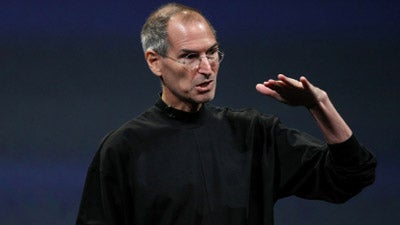
We are in a world that won’t stand still. Technology is changing all the time, new things arrive and old tech vanishes. New companies rise, and established giants fall. In that kind of world, staying still is falling behind. It’s not enough to just maintain what you have when other people are running forward as fast as they can. That’s why visionary leadership is so important to driving success. So what is a visionary leader?
Visionary leaders are people who are able to see what could be, and then have the drive to not only prepare their companies for the future but even to create that future themselves.
Steve Jobs: The Ideal Visionary Leader
 When I think of visionary leaders, the first name that comes to mind is Steve Jobs, the legendary CEO of Apple. When he was just 21 years old, he was one of the founders of the company, helping to lead the computer revolution.
When I think of visionary leaders, the first name that comes to mind is Steve Jobs, the legendary CEO of Apple. When he was just 21 years old, he was one of the founders of the company, helping to lead the computer revolution.
Jobs had Apple on the cutting edge of technology, pushing the envelope and trying new things. But a few years later, the board of directors at Apple wasn’t comfortable with his visionary style; they didn’t like that he took big chances. They thought that what the company needed was a professional manager, someone to rein Jobs in and just keep the company moving steadily along.
By September 1985, Steve Jobs was out at Apple. It wasn’t long before the company was in trouble. The company was nearly bankrupt and needed a miracle to turn things around.
Their miracle was the return of Steve Jobs in 1997. The days of professional managers and playing it safe were over; if Jobs was going to come back, he was going to do it his way – and it worked. He had a big hit early on after his return with the iMac, but his vision was even bigger. Or, you could say, smaller. He had a vision of a world where everyone was using small, handheld devices. The iPod arrived in 2001, the iPhone in 2007, and the iPad in 2010.
Steve Jobs had a vision, and he worked to make it a reality. He worked to make sure that Apple would be the leader in this new world that he created, and the company is still thriving and honoring his legacy of innovation and vision today.
I was fortunate enough to meet him, first during his years away from Apple. Even then, he had a vision for the future. I can say from firsthand experience that the stories about him are no exaggeration; he was the real deal. You can’t be more visionary than that.
Characteristics of Visionary Leaders
Steve Jobs may be the greatest example of a visionary leader, but you can do it, too. It’s about having the right mindset and approach to problems, challenges, and opportunities.
Here are five key characteristics of visionary leaders.
- Strategic Foresight: Visionary leaders have the ability to anticipate future trends and challenges. They understand the potential implications these trends could have on their business and on the industry as a whole. Because they can see these things coming, they are able to develop strategies that prepare them for the future, rather than just responding to what’s already happened.
- Inspirational Communication: Visionary leaders have a compelling way of communicating that inspires and motivates others. Steve Jobs had what was often called a “reality distortion field,” getting others to buy into his vision. Leaders like that don’t just have a vision, but they are able to share it with their team.
- Innovative Thinking: Visionary leaders take innovative approaches to problem-solving. They encourage creativity and are open to exploring new ideas and solutions. They don’t just want to do things the same old way; they want to find a better way.
- Emotional Intelligence: They can understand and manage their own emotions, as well as empathize with and influence others. That helps them to develop deep personal relationships, build strong teams, and know how to solve complicated situations where other people aren’t fitting together.
- Resilience and Adaptability: Visionary leaders show resilience in the face of failure or challenges. They adapt quickly to change, and see obstacles as opportunities to learn and grow. This resilience not only helps them to keep moving forward toward achieving their vision but also gives their teams a strong sense of confidence.
These characteristics empower visionary leaders to drive change, inspire innovation, and guide their organizations towards a successful future.
Does that sound like you? I hope so!
How Visionary Leaders Drive Change
A visionary leader shines brightest during times of change. Their strong sense of purpose and clear communication of that vision guides and motivates their entire team through difficult times of uncertainty. So let’s look at how visionary leaders drive change in their companies.
First, as we’ve mentioned already, visionary leaders have to start by setting a powerful, compelling vision for the future. That vision serves as a roadmap for the entire organization. It’s how people determine their direction and priorities. The vision is going to be bold, it’s going to be looking ahead toward what could be, and it will encourage everyone to go after new innovations to solve problems.
Next, visionary leaders are going to create a culture of innovation. The vision has to be there, but the culture is what really empowers everyone to make that vision a reality. It has to be a culture where innovation is encouraged, where it is valued and rewarded. Of course, not every idea will work; visionary leaders support risk-taking and trying things out. They will learn from failure and encourage everyone else to do the same.
It’s important for visionary leaders to lead by example. They don’t just talk the talk; they walk the walk. They are leading the way in modeling innovation and change, and encouraging new initiatives. When the leader leads by example, that sets a tone for the entire organization and gets more and more people to follow suit.
To get the most out of their team, visionary leaders invest in talent and development. They want to be surrounded by star players. The more great players you have on your team, the more successful you will be. It may sound obvious, but in all too many organizations, insecure leaders don’t want to bring in people who might be smarter than they are. Don’t fall into that trap! Hire great people, and invest in their development to help them become even better. It will benefit the entire company.
A plan is great, but a visionary leader must always be flexible about responding to change. An adaptable, responsive leader will do a better job of responding quickly to market changes or new technologies, so that they can adjust their vision in real time and keep their company on track to win the future.
Instead of trying to control everything, visionary leaders delegate authority and empower team members to take initiative. By trusting their teams and giving them the autonomy to make decisions, they facilitate a faster and more effective innovation process.
Through these strategies, visionary leaders are able to create and sustain an ongoing cycle of innovation and change. They ensure their organizations remain dynamic, relevant, and competitive in an ever-changing business landscape.
3635 Views












